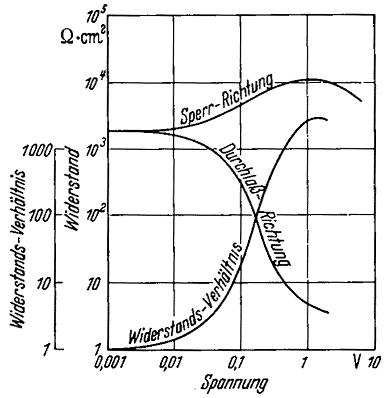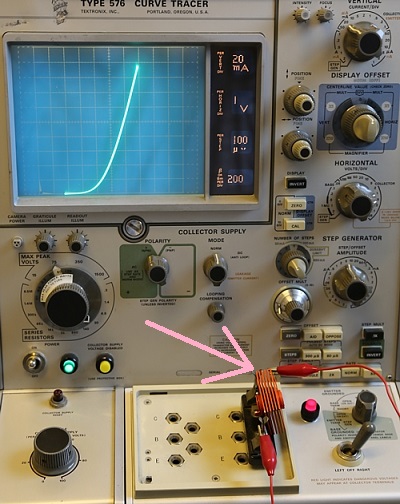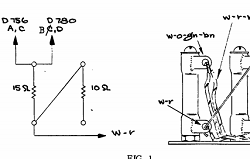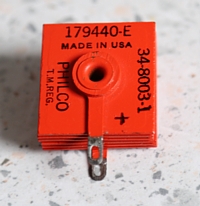Since 1993 Copyright Notice
About Selenium Diodes and Copper-Oxide diodes in old instruments.
Opinions
You will read in the forums, that old Selenium diodes are dangerous items. "Experts" tell you, these diodes can suddenly get defective, and spray poisonous gas, or bad substances in your direction. This seems to happen mainly to those people writing these warnings, because it never happened to me. I have seen many of them. Initially I always thought when I see those cooling plates, it's a poisonous Selenium Diode, but many times they were actually even the older Copper Oxide diodes. I wonder how many good working copper-oxide diodes, have been replaced by replacement circuits, on the advise of those forum expert writers. And then guess what they did with the "poisonous" object, they just throw it in the dust bin. Such a replacement, I suppose is electrical not very important for circuits needing indeed just a diode only, but it will impair good functioning of instruments, when the forward voltage, reverse leakage, and a few more things, affect the calibration. It may do the trick perhaps to re calibrate, but I would not count on it. Reason is, you can never imitate the characteristic of one diode technology by another.
Just to give you an example, the greater part of available diodes show no function below the threshold voltage. A germanium diode, has not just a lower threshold voltage, it WORKS at any voltage, no matter how low. It is just at higher current, you will see this 0.3Volt forward voltage but you can as well rectify a 50mV signal with it, as long as you load the resulting DC voltage with a high impedance. You can't do that with a silicon diode. Below 400mV, it stops working.
Before semiconductor diodes, we had already metal diodes. The most famous being the crystal receiver. A metal diode is not something inferior. They have disadvantages but also advantages. In the range below 0.7V a metal diode is much superior to Silicon, and not just a little bit. A silicon diode is "dead" below it's threshold limit, but a (single cell) Metal diode begins to work much below 0.7V already. A replacement for a low power metal diode is a Germanium High Current diode like 1N93, with a series resistor connected to it. However Germanium is too good, because at low current, they work stil below 0.3V, which a metal diode CAN do also, but not as good. Consider simply replacing a broken Selenium diode, with another good Selenium diode. They're not impossible to find, and even still made (when I write this in 2021) for exact replacement purposes. Also, Selenium diodes have one property where they outdo Silicon by far. They are very resistant against short overload conditions. Unlike a semiconductor, which after an overload must be considered unreliable. For this reason, Selenium rectifiers are still made.
It is very strange, but anything having to do with diodes, is a field where amateurs feel competent to advise inexperienced people. I stressed this point at some other places of this website, when using vacuum tube diodes, where we see the same effect. This becomes more difficult, as reading data sheets is regarded a waste of time in this group of users.
Forums are nice on the one hand, but generally it goes wrong when it's just gut feeling what they are writing about, but pretending to be specialists. Go to any forum and ask for sound difference of Chinese 300B vs. genuine Western Electric NOS 1930. You will quickly be advised about "sound" by people who only know about Western Electric 300B from internet pictures. But they will tell you how it sounds. Think about that, before you believe it.
For replacing Selenium diodes, it's exactly this kind of "knowledge" you can quickly pick up. I do not have the real number for this of course, but I guess 95% of the Selenium Diode warnings is by people who never saw one in reality. And from the remaining 5%, I dare say that virtually nobody took the trouble of making a plot of the current vs. reverse voltage. But if not, what are these people talking about? Only about what they "think" and not about what they know. Strangely however, when advised by people who really know, they begin to argue, instead of learning something.
Some (partial only) rectifier history
Before electrical diodes, all kind of other methods were in use. Like a vibrating relay, or an AC motor, driving a DC generator. An interesting item is the wet diode, which is nothing but big plates of metal, in a conductive liquid. WIth one plate of lead, and the other of aluminum, it becomes a semiconductor. Clearly, with the liquid, this can never become a high voltage diode of course, but for very low voltage, like 6.3 Volts, at high current, these worked good. It is perhaps forgotten a little bit, but before the gasoline engine was invented, the streets of New York were full of electric cars, using at home such rectifiers for charging. This whole hype of electric driving, we had it in the 1880's already. It was obsoleted after the gasoline engine was invented.
When was a kid, I remember the speed of the merry-go-round, was controlled with a huge electric cell. It had a water bath of 80x80 centimeter, and very slowly, and metal plates were dived into the liquid, with a handle. It looked like a very big variable capacitor. The operator would slowly sink the plates in the liquid, and while the merry-go-round would pick up speed, the liquid began to boil. Kind of primitive, but it worked well, and there could be not much wrong with it. I just felt a bit sorry for that man, as I realized as a kid, his work was dangerous.
The crystal rectifier, is quite the opposite. Delicate and only capable of low voltage, low current. It was discovered in 1874 by the German Professor K.F. Braun, a wireless enthusiast and Nobel Prize winner. A semiconductor effect was already found with crystals of Zinc Oxide, Copper Sulfite, and a few others. In 1878 Werner von Siemens discovered the Selenium diode. However it resulted from the interest to make photo detectors. It would take another 50 years (!) before Selenium rectifiers as we know them, were coming on the market.
In 1925 came the Copper Oxide diodes, which look like stacked coins. These are made by copper oxide on one side of a copper plate, and then add a conductive layer over the oxide. To make them work good, it required copper with a very low oxygen content, which is hard to get, and normal electrical copper can not be used. In addition, specific impurities of the copper were needed, and also the lack of some others. This was one of the things, which made those so difficult to manufacture. It appeared that Chilean copper was the best, and some other copper could not be used at all. The tragedy of the Copper Oxide diode was, the fine details of the process were kept secret, just the things everybody could find out were patented. This has always been the tragedy of secret processes: You can patent them, and 25 later, when the patent runs out, the patent papers are a free guideline for anyone. Or, you keep the tricks secret, and you can use it as long as you want. For Copper Oxide diode, a mix of patents and secrets were used, but it means today, the secret part is lost, as the people who di know, refused to speak about it, until they died.
Moreover, the temperature at which the oxide layer is grown is around 1000 degrees Celsius, and must be kept very precise. The speed of the cooling down process , influenced the impedance. Meaning, if the copper was cooled down slowly, the break down voltage was higher. If cooled down fast, the break down voltage was lower, but such could tolerate higher current. The Selenium diode had a much easier production process. Copper oxide diodes were only used for applications where low forward voltage was desired. Such as in AC voltmeters. In terms of the "best" diodes, Copper Oxide is better than Selenium. Just Selenium is incredibly tolerant against surge current, outdoing silicon by far, even today. Also Selenium is lower cost to produce, and no production secrets. So it was no wonder, Copper Oxide diodes disappeared.
The Selenium diode was invented already in 1928. Even though when easier to make as copper diodes, production was still a recipe, of the small additions to the Selenium layer, combined with several process steps, some under high pressure and high temperature. This created the desired crystal structure, for getting a low series resistance. As a final step, the reverse voltage is increased by a forming process which takes place under heat as well, with electric pulses. The resulting Selenium plated metal sheets, are relatively robust, and can be stacked easily, after which the diode is sealed with paint. Old data books write 60.000 hours life time, which was much better than any electron tube. Besides Selenium diodes could be stacked to any desired voltage, or be made as large as needed, to get any desired current rating. .
Today's applications
 Selenium diodes are still made by a UK company, called gdrectifiers, and also by a USA company called Cougar Electronics Corp. The UK company says they build those are replacement parts for old equipment. The USA company goes one step further. They say, their Selenium diodes are self recovering even in case of extreme surge current, whereas silicon will damage permanently, at much lower surge current. Also Selenium cells can be used in reverse at their breakdown voltage, as long as maximum heat development is not exceeded. This is also something you can not do with silicon diodes. Unless it's a Zener, you can not develop maximum heat at breakdown. So Selenium diodes are robust, hard to destroy, self recovery parts. It sounds weird, but they advise Selenium diodes for high reliability applications. Another application is for high energy surge protectors. Like 10 Selenium diodes in series would for instance have a forward voltage of 250V. Any voltage above that gets brutally clamped, with extreme surge currents possible, because such devices are big size, and the diodes have a large surface. So unlike with the PN junction of a semiconductor, the heat is generated at the surface of a thick metal plate.
Selenium diodes are still made by a UK company, called gdrectifiers, and also by a USA company called Cougar Electronics Corp. The UK company says they build those are replacement parts for old equipment. The USA company goes one step further. They say, their Selenium diodes are self recovering even in case of extreme surge current, whereas silicon will damage permanently, at much lower surge current. Also Selenium cells can be used in reverse at their breakdown voltage, as long as maximum heat development is not exceeded. This is also something you can not do with silicon diodes. Unless it's a Zener, you can not develop maximum heat at breakdown. So Selenium diodes are robust, hard to destroy, self recovery parts. It sounds weird, but they advise Selenium diodes for high reliability applications. Another application is for high energy surge protectors. Like 10 Selenium diodes in series would for instance have a forward voltage of 250V. Any voltage above that gets brutally clamped, with extreme surge currents possible, because such devices are big size, and the diodes have a large surface. So unlike with the PN junction of a semiconductor, the heat is generated at the surface of a thick metal plate.
When is an diode ideal?
That answer can be given quickly. At the rated forward current, it has no forward voltage, and in reverse condition it has no capacitance. That would be ideal. Unfortunately, this doesn't get us any further :)
For small power supply applications, today's silicon diodes are close to ideal. You can buy such for 1 cent, which have a peak reverse voltage of 1000V, and forward voltage of 0.7V at 1Ampere. Just the larger types, so 50 or 100's of ampere are very bulky, and get very hot. So, not really ideal, but still very good.
For RF applications, we need them with low capacitance. Such exist, but the low capacitance comes from small chips, with the drawbacks of this.
Specifications
Selenium Cells were made, ranging from 50kV reverse voltage, 5mA forward current, to 50V reverse voltage, 100.000A forward current. The voltage specified, in old data books was usually the RMS Mains voltage. A single cell is marginally above 20V. So to rectify 117V AC in the USA, it needs 6 cells. Yet one "20V" cell has a breakdown voltage of 30V.
For small signal applications, it becomes more difficult to understand.
Here, the diodes are usually intended for changing AC voltage to DC. WIth large signal that is easy, but how will you rectify a 20mV signal? This can never be done with silicon.
Myself, I have several pieces of old equipment with Selenium diodes, and they all work good. Initially I was reading the forum babble too. So yes, I wanted to replace those bad, dangerous, poisonous, and unreliable items. But with instruments, of course the meter scale, and the whole functioning takes into account what curves Selenium diodes have. So there is quite some risk to compromise the quality of the instrument.
So looking into curves of Selenium diodes, I can only say, those curve were always EXCELLENT. Though these Lucas branded, early type silicon diodes, in the AVO Mk4, I sometimes had to replace.
For small signal, Silicon diodes are the worst choice. To understand this better, throw overboard all that forum babble, you are probably infected with that as well. Of course it has to do with the higher forward voltage of Silicon, but that is not the real issue. Germanium has not only a lower forward voltage, but unlike Silicon, there a rectifier function BELOW the forward voltage as well. And not just a little bit below, but at EVERY voltage. That is why you can use a Germanium diode, to detect (and rectify) a signal if just a few millivolts. Whereas a Silicon diode is simply dead below 0.4 Volts.
 Here comes a good thing with Selenium. These diodes have this interesting property as well, to begin working much below their rated forward voltage. To rectify small signal, this makes them very good as well. Not for radio, because of their capacitance, but for AC voltmeters they are ideal. Not as ideal as Germanium, but quite close.
Here comes a good thing with Selenium. These diodes have this interesting property as well, to begin working much below their rated forward voltage. To rectify small signal, this makes them very good as well. Not for radio, because of their capacitance, but for AC voltmeters they are ideal. Not as ideal as Germanium, but quite close.
Rectification begins when the forward resistance is lower than the reverse resistance. From this graph, it can be seen, this begins at 5mV already. With Silicon this is fully impossible, it has no significant forward resistance below 0.5V.
Selenium diodes are just two metal plates with some Selenium composition in between. And voila: A real semiconductor, and a good one! Only maximum reverse voltage is not very high, but resistance is much lower than vacuum tubes. You can even take them apart, there are dark layers on the metal. Pile it back together, and they still work. I tried that with an old Siemens Selenium bridge rectifier. I do not intend to do so with my AVO (Made by LUCAS) diodes. But the simplicity of such diodes is amazing.
It's just there is a high voltage drop at high current. We all know that. So though they appear low voltage, high current, if compared to vacuum tubes, they do get very hot at high current. But what happens at low current? They do not get hot, do lifetime expectancy is good. There there is no large voltage drop any more, and here comes the advantage vs Silicon: So no voltage drop, and they work already at very low voltage.
With Silicon diodes, if you want to use them a little below 0.7V you can do so, but current flow will be small. You can increase the current flow by putting several in parallel, this needs no explanation. But a quicker way to achieve this, is using a very high current Silicon diode. Like a 6 Ampere diode, and use this to rectify small signal. This is exactly why you will find such (6A) diodes in parallel of the meter of the Mk4 tube tester, to protect it. (And not a small signal diode, as the forum babblers will suggest you).
The Copper Oxide diode of the AVO two panel tester, is not used to protect the meter. This meter is not very fragile anyway. It's purpose is only to generate the negative grid voltage, for the "set zero" knob. It means, in this tester you can replace it by a Silicon diode if needed, and when the Selenium diode seems to work good, you can just leave it in.
![]()
This Silicon Diode (I have the red and black leads attached to it) was used by some repair man, long ago. It was to repair this supposedly bad LUCAS Copper Oxide diode. The forward voltage of the LUCAS diode is appr 1.4V at small signal, so replacing it could be by two silicon diodes in series, and that's all you need to do. In some equipment, were forward voltage does play a role however, you need to be more careful what you are doing. Now believe it or not, in the AVO tube tester, where this LUCAS diode belongs inside, the man reversed the panel meter by mistake. Which had no effect on the function, as he swapped all some other connections too, as he found their polarity was "wrong". So he must have thought it was all connected wrong. It's crazy, but such people exist. Just a little problem remaining with the he negative grid voltage, because that was now positive. So he though the Copper Oxide diode was bad, and he replaced it with a Silicon diode. And of course reversing it, so to get negative grid voltage again. He happily put it back together and the tester worked well, and used like that for some 25 years. Until I had to clean the meter, and I found out the meter was put in reversed. I had of course the same strange experience, some parts were mounted reversed. And the were! Believe me it took me some time to understand this mess, and repair it all back to normal. And then, the "broken" Copper Oxide diode worked again.
It was nice of him, he let in the old "bad" Copper Oxide diode, but when I connect it to a curve tracer, there is nothing wrong with it. Indeed after re connecting everything correctly, the tester worked normal, with it's original Selenium diode.
Take good bote here, the scale of the HAMEG Curve tracer is 3V per division. So the Copper Oxide diode as well as the Silicon replacement diode, have 1.4V forward voltage. Unfortunately I lost the Silicon diode, but it was a LUCAS High Voltage diode, with two diodes in series, in one epoxy housing.
This is the old LUCAS Copper Oxide Diode of an AVO Two Panel Valve tester. I believe the same are in the AVO Mk1 and Mk2. (Very well hidden). At least they look the same.
Texts have come off a little bit, but the readable part is: .../6A. It is much too small for 6Ampere, so 6A means 0.6A here.

Read my report about the Tektronix 576 curve tracer, go to the part about testing diode curves.
This 6-Cell diode of type 34-8003-1 Selenium diode was used for the above curve testing. The forward voltage can be seen, is 5V which makes sense as it has five plates, which normally have 1V each. So the reverse voltage is probably such that it can rectify the USA mains voltage of 117AC. I have not tested the breakdown voltage, but I think you can just normally rectify 117V AC with this diode. Given the forward voltage is only 5V, it should be able to to 50mA-
Each plate by itself is a diode. The anode is the one side, the cathode the other, and the junction layer is in between. So with help of metal rings, they could be very easily stacked, and in the center is just a rivet, or a long screw to keep it all together. Even single Selenium rectifiers plates were sold, where the user could stack them, to get the required break down voltage. On Ebay you can still find even High Voltage diodes, stacked of thousands of paper- thin plates. Doing several kV. You hardly recognise those as such, since is each plate is only a tiny ring, and they're all stacked on some isolating bar, appearing like a power resistor. These diodes had very good reliability, because if one of 5000 (!) shorts, the other 4999 still work.

Interesting Replacement instructions by Tektronix
References:
- Jackson, Selection and Application of Metallic Rectifiers, 1957
- Mierde & Kroczek, Selengleichrichter, 1959
- RFT, Selen Gleichrichter
